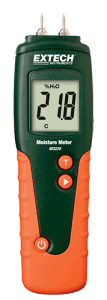What this tool does

You can use this tool for many purposes, usually with help of a moisture meter (see photo below), including the determination of average relative humidity. Enter the air temperature and equilibrium moisture content of a sample piece of wood that has been in the space. The RED tool will calculate the average relative humidity for you.
Use this tool to decide if new wood flooring has been properly acclimated. You will need a moisture meter (see photo below) and this RED tool to determine when the new flooring is at the ideal 6 to 9 percent equilibrium moisture content (EMC).
If you burn firewood, you can use this tool and your moisture meter to determine the equilibrium moisture content (EMC) based on the average outdoor temperature and relative humidity. Dry firewood should have an EMC of 20 percent or less.
Wood rot has been reported to occur at moisture contents above 20 percent. Use this RED tool and a wood moisture meter to find a safe combination of ambient temperature and relative humidity in order to prevent rot problems.
Calculated values
- Relative humidity – average relative humidity of the air surrounding the sample of wood over the last week or so. This assumes that the wood has reached equilibrium with its surroundings and is not in the process of drying (such as firewood) or wetting.
- Equilibrium moisture content (EMC) – the moisture content of a wood sample when the sample is in equilibrium with the surrounding air (it is neither drying nor wetting). Wood will eventually reach equilibrium if it remains in the air where the temperature and relative humidity are constant.
Tips
- Clicking the label for any input or result will cause a popup help box to appear. This help box includes the allowed and normal values (for inputs).
- The equilibrium moisture content of wood is affected more significantly by the relative humidity than by the temperature of the surrounding air.
- A wood moisture meter is a useful tool to use with this RED Calc Wood Moisture Content tool.
- Wood dried outdoors, firewood, for example, usually reaches an equilibrium moisture content of 15 to 20 percent. Freshly-cut (green) firewood usually has a moisture content around 100 percent, meaning half the weight of the wood is water.
- Kiln dried lumber usually has an equilibrium moisture content of 6 to 8 percent when removed from the kiln.
- When the moisture content of wood is above 20 percent moisture, it can support the growth of wood-rotting fungi.
Background
Wood is hygroscopic, which means its moisture content will change in relation to the relative humidity (RH) and temperature of the surrounding air. As relative humidity increases, the moisture content of wood increases; as temperature increases, the moisture content of wood decreases. When the wood sample fully acclimates to the conditions of the surrounding air, it reaches its Equilibrium Moisture Content (EMC).
The moisture content of a sample is defined as the ratio of the weight of the water in the sample to the weight of the sample with all moisture removed (dry weight), expressed as a percentage: 100 x (water weight) / (dry weight).
Thus, if freshly cut firewood is 100 percent moisture content, half of its weight is water.
Hardwood milled for furniture, flooring, and cabinets is usually carefully kiln dried to 6 to 8 percent moisture content. Once this lumber leaves the kiln, it should be properly stored in conditions that will not result in the regain of moisture. For a 7 percent wood moisture content, this means 35 percent relative humidity at 70 °F (21 °C). If the surrounding air conditions are changed to 80 °F (27 °C) and 80 percent relative humidity, the EMC of the wood will more than double to almost 16 percent.
Best Practices
When installing new wood flooring, it is best if it has an Equilibrium Moisture Content (EMC) from 6 to 9 percent; this equates to 70 °F (21 °C) at 30 to 50 percent relative humidity. Make sure you measure the moisture content of the flooring with a moisture meter when it arrives at the site. The goal is for the new flooring to reach its equilibrium moisture content based on the surrounding temperature and relative humidity before installation.
Wood Moisture Meters
Moisture meters are used to measure the moisture content of wood and other hygroscopic materials, such as the paper surface of drywall.
For common usage, two types of moisture meters are commercially available, pin and pinless. Pin-type meters measure the electrical resistance of wood fibers. The resistance becomes increasingly lower as the moisture content increases. For measurement, two metal pins are driven into the wood and the electrical resistance is translated as moisture content. The major advantage of pin-type meters is that they can be used on rough and curved surfaces, such as unplaned lumber, logs, and textured concrete surfaces.
Pinless-type meters use the dielectric properties of the wood, requiring only surface contact rather than pins or probes. These meters have the advantage of not damaging the material with pin marks, but they don’t work on rough or curved surfaces. The area being sampled must be large enough for complete contact with the sensor pad of the meter.
Most moisture meters are calibrated for a particular material or group of materials. Douglas fir is the species to which most wood meters are calibrated. Meter manufacturers provide information for correcting readings for species other than the one for which the meter is calibrated.
The ability to measure moisture content in wood is important for many reasons, including acclimation of wood flooring, kiln drying of lumber, seasoning firewood, preventing rot in wood, and predicting the expansion and contraction of wood. Make sure you know your moisture meter well before taking measurements.